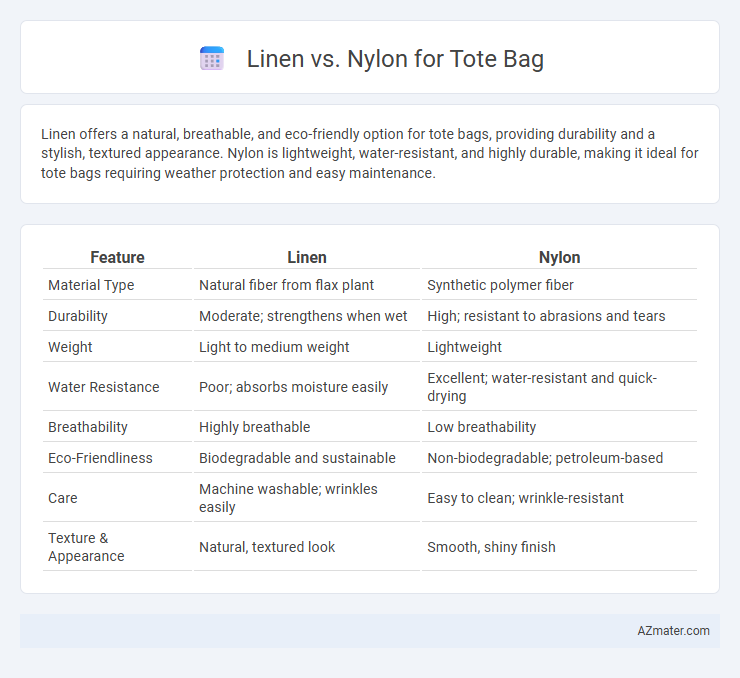Linen offers a natural, breathable, and eco-friendly option for tote bags, providing durability and a stylish, textured appearance. Nylon is lightweight, water-resistant, and highly durable, making it ideal for tote bags requiring weather protection and easy maintenance.
Table of Comparison
| Feature | Linen | Nylon |
|---|---|---|
| Material Type | Natural fiber from flax plant | Synthetic polymer fiber |
| Durability | Moderate; strengthens when wet | High; resistant to abrasions and tears |
| Weight | Light to medium weight | Lightweight |
| Water Resistance | Poor; absorbs moisture easily | Excellent; water-resistant and quick-drying |
| Breathability | Highly breathable | Low breathability |
| Eco-Friendliness | Biodegradable and sustainable | Non-biodegradable; petroleum-based |
| Care | Machine washable; wrinkles easily | Easy to clean; wrinkle-resistant |
| Texture & Appearance | Natural, textured look | Smooth, shiny finish |
Introduction: Linen vs Nylon Tote Bags
Linen tote bags offer natural breathability, durability, and eco-friendliness, making them ideal for sustainable fashion and everyday use. Nylon tote bags provide lightweight strength, water resistance, and easy maintenance, suited for active lifestyles and travel. Choosing between linen and nylon depends on preferences for texture, durability, and environmental impact in tote bag selection.
Material Origins: Linen and Nylon Explained
Linen is a natural fiber derived from the flax plant, known for its breathability, durability, and eco-friendly properties, making it a popular choice for sustainable tote bags. Nylon, a synthetic polymer invented in the 1930s, offers high strength, water resistance, and lightweight characteristics often preferred for durable, weather-resistant totes. Understanding the distinct origins--plant-based for linen and petrochemical-based for nylon--helps consumers choose totes based on environmental impact and functional needs.
Durability Comparison: Linen and Nylon
Nylon offers superior durability for tote bags due to its high tensile strength, resistance to abrasion, and water-repellent properties, making it ideal for heavy-duty use and harsh weather conditions. Linen, derived from flax fibers, provides moderate durability with natural breathability and resistance to wear but is more prone to tearing and moisture damage compared to nylon. Choosing between linen and nylon for tote bags depends on prioritizing natural texture versus long-lasting, rugged performance.
Eco-Friendliness and Sustainability
Linen tote bags, made from flax fibers, offer superior eco-friendliness due to their biodegradability and lower water and pesticide usage during cultivation compared to nylon, which is a synthetic polymer derived from petrochemicals with significant environmental impact. Linen production emits fewer greenhouse gases and supports sustainable farming practices, while nylon contributes to microplastic pollution and relies on non-renewable resources. Choosing linen tote bags promotes sustainability through natural, renewable materials that decompose without harming ecosystems, contrasting with the long-lasting environmental footprint of nylon alternatives.
Weight and Comfort in Daily Use
Linen tote bags are typically lightweight and breathable, offering superior comfort for daily use due to their natural fiber composition that allows better air circulation. Nylon tote bags, while often more durable and water-resistant, tend to be heavier and less breathable, which may cause discomfort during extended wear. Choosing between linen and nylon depends on the need for a lightweight, comfortable bag versus a sturdier, more weather-resistant option.
Style and Aesthetics: Linen vs Nylon Bags
Linen tote bags offer a natural, textured appearance that exudes a rustic and organic charm, making them ideal for casual and eco-conscious fashion. Nylon totes provide a sleek, smooth finish with vibrant color options, lending a modern and sporty aesthetic suitable for urban and active lifestyles. Both materials allow for versatile styles, but linen emphasizes earthy elegance while nylon highlights contemporary vibrancy.
Maintenance and Ease of Cleaning
Linen tote bags require gentle hand washing or spot cleaning to maintain fiber integrity, as harsh detergents can weaken the fabric and cause shrinkage. Nylon tote bags are highly durable and machine washable, offering excellent resistance to stains and quick drying, making maintenance straightforward. Choosing nylon ensures easier cleaning and long-lasting use, while linen demands more delicate care to preserve texture and appearance.
Water Resistance and Weather Suitability
Nylon tote bags offer superior water resistance compared to linen, making them ideal for rainy or wet conditions. Linen, a natural fiber, absorbs moisture more easily and may become heavy or damaged when exposed to prolonged dampness. For durable weather suitability and protection against water, nylon is the preferred choice in tote bag materials.
Cost Analysis: Linen vs Nylon Tote Bags
Linen tote bags typically have a higher upfront cost due to the natural fiber's labor-intensive processing and eco-friendly appeal. Nylon tote bags offer a more budget-friendly option, benefiting from mass production and synthetic material efficiency. Long-term durability and maintenance costs may favor linen, which is biodegradable and strengthens with use, over nylon's susceptibility to wear and environmental impact.
Which Tote Bag Material Is Best for You?
Linen tote bags offer natural breathability, durability, and an eco-friendly appeal, making them ideal for those seeking sustainable and stylish everyday use. Nylon tote bags provide superior water resistance, lightweight strength, and easy maintenance, perfect for active lifestyles and travel purposes. Choosing between linen and nylon depends on your priorities for environmental impact, durability, and practical functionality in daily wear.

Infographic: Linen vs Nylon for Tote Bag
 azmater.com
azmater.com